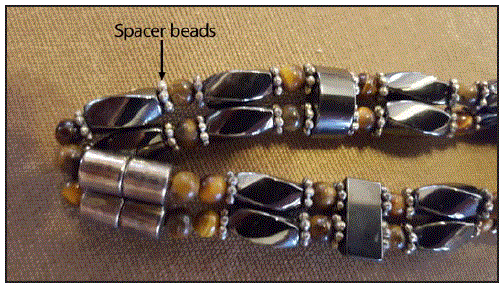Notes from the Field: Lead Poisoning in an Infant Associated with a Metal Bracelet — Connecticut, 2016
Weekly / September 1, 2017 / 66(34);916
Please note: An erratum has been published for this report. To view the erratum, please click here.
Patricia Garcia, MD1; Jennifer Haile, MD1 (View author affiliations)
View suggested citation- pdf icon [PDF]
In September 2016, routine screening of a female infant aged 9 months in Manchester, Connecticut, showed normocytic anemia and a blood lead level of 41 μg/dL (levels exceeding 5 μg/dL are abnormal) (1). The child was cared for only in the home, which was built in 1926. Epidemiologic investigation identified two interior window wells with peeling lead-based paint; however, the health department concluded that the windows were unlikely the source of exposure, given the lack of accessibility to these areas by the child. The child’s three siblings, ranging in age from 3–5 years, had blood lead levels of <3 μg/dL.
The parents reported that the child intermittently wore a handmade “homeopathic magnetic hematite healing bracelet” that they had purchased from an artisan at a local fair (Figure). The child wore the bracelet for teething related discomfort and was sometimes noted to chew on it. Small spacer beads from the bracelet tested at the Manchester Health Department were positive for lead (17,000 ppm). No identifying marks indicating metal content or manufacturer were found on the bead. The vendor records were not available, and the bracelet maker could not be located.
Lead poisoning occurs primarily through oral ingestion of lead containing products. Lead paint, dust, and contaminated soil are the most common sources of lead exposure in children; however, nonpaint sources are often identified in acute poisonings (1,2). Cases of severe lead poisoning and death were linked to lead-containing charms and jewelry marketed to children in 2003 (3) and 2006 (4), resulting in large-scale recalls. In 2010, the Consumer Product Commission set the limit of lead content in items manufactured and marketed for children at 100 ppm.* This standard results in numerous recalls of children’s jewelry each year†,§ but does not apply to items that are not intended for use by or in children’s products.
Clinicians should be aware of the potential for lead poisoning in children who have ingested or mouthed any metal objects, especially jewelry. Caregivers should be made aware of the risks for lead poisoning resulting from children wearing or handling handmade or adult metal jewelry, even if items are manufactured or purchased in the United States, because infants have natural mouthing behaviors; these items can also pose a choking hazard for small children (5). Cases of lead poisoning in these situations should be reported immediately to local public health departments so that timely investigation can be conducted and the source eliminated to prevent further cases of poisoning.
Conflict of Interest
No conflicts of interest were reported.
Corresponding author: Patricia Garcia, pgarcia01@connecticutchildrens.org.
* Consumer Product Safety Improvement Act of 2008. https://www.cpsc.gov/s3fs-public/pdfs/blk_media_cpsia.pdfpdf iconexternal icon.
† Consumer Product Safety Commission. Mars retail group recalls M&M branded jewelry due to violation of lead standard. 2016. https://www.cpsc.gov/Recalls/2016/mars-retail-group-recalls-mms-branded-jewelryexternal icon.
§ Consumer Product Safety Commission. Things Remembered recalls children’s jewelry due to violation of lead standard. 2016. https://www.cpsc.gov/Recalls/2016/things-remembered-recalls-childrens-jewelryexternal icon.
References
- CDC. Blood lead levels in children aged 1–5 years—United States, 1999–2010. MMWR Morb Mortal Wkly Rep 2013;62:245–8. PubMedexternal icon
- Gorospe EC, Gerstenberger SL. Atypical sources of childhood lead poisoning in the United States: a systematic review from 1966–2006. Clin Toxicol (Phila) 2008;46:728–37. CrossRefexternal icon PubMedexternal icon
- CDC. Lead poisoning from ingestion of a toy necklace—Oregon, 2003. MMWR Morb Mortal Wkly Rep 2004;53:509–11.
- CDC. Death of a child after ingestion of a metallic charm—Minnesota, 2006. MMWR Morb Mortal Wkly Rep 2006;55:340–1. PubMedexternal icon
- Committee on Injury, Violence, and Poison Prevention. Prevention of choking among children. Pediatrics 2010;125:601–7. CrossRefexternal icon PubMedexternal icon
 FIGURE. Bracelet with spacer beads containing lead, resulting in lead poisoning of an infant — Connecticut, 2016
FIGURE. Bracelet with spacer beads containing lead, resulting in lead poisoning of an infant — Connecticut, 2016

Photo/Kimberly Dubanoski, Manchester Health Department, Connecticut
The figure above is a photograph showing a bracelet with spacer beads containing lead, resulting in lead poisoning of an infant in Connecticut in 2016.
Suggested citation for this article: Garcia P, Haile J. Notes from the Field: Lead Poisoning in an Infant Associated with a Metal Bracelet — Connecticut, 2016. MMWR Morb Mortal Wkly Rep 2017;66:916. DOI: http://dx.doi.org/10.15585/mmwr.mm6634a6external icon.
MMWR and Morbidity and Mortality Weekly Report are service marks of the U.S. Department of Health and Human Services.
Use of trade names and commercial sources is for identification only and does not imply endorsement by the U.S. Department of
Health and Human Services.
References to non-CDC sites on the Internet are
provided as a service to MMWR readers and do not constitute or imply
endorsement of these organizations or their programs by CDC or the U.S.
Department of Health and Human Services. CDC is not responsible for the content
of pages found at these sites. URL addresses listed in MMWR were current as of
the date of publication.
All HTML versions of MMWR articles are generated from final proofs through an automated process. This conversion might result in character translation or format errors in the HTML version. Users are referred to the electronic PDF version (https://www.cdc.gov/mmwr) and/or the original MMWR paper copy for printable versions of official text, figures, and tables.
Questions or messages regarding errors in formatting should be addressed to mmwrq@cdc.gov.